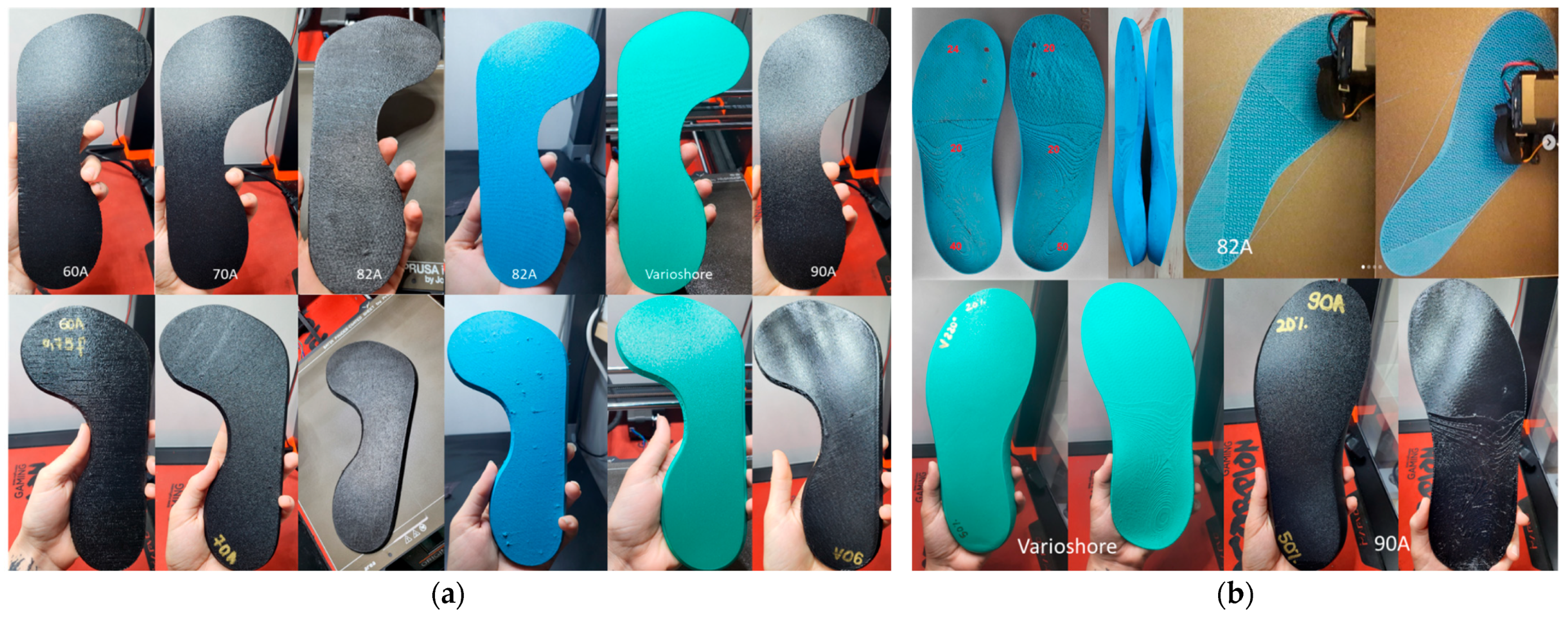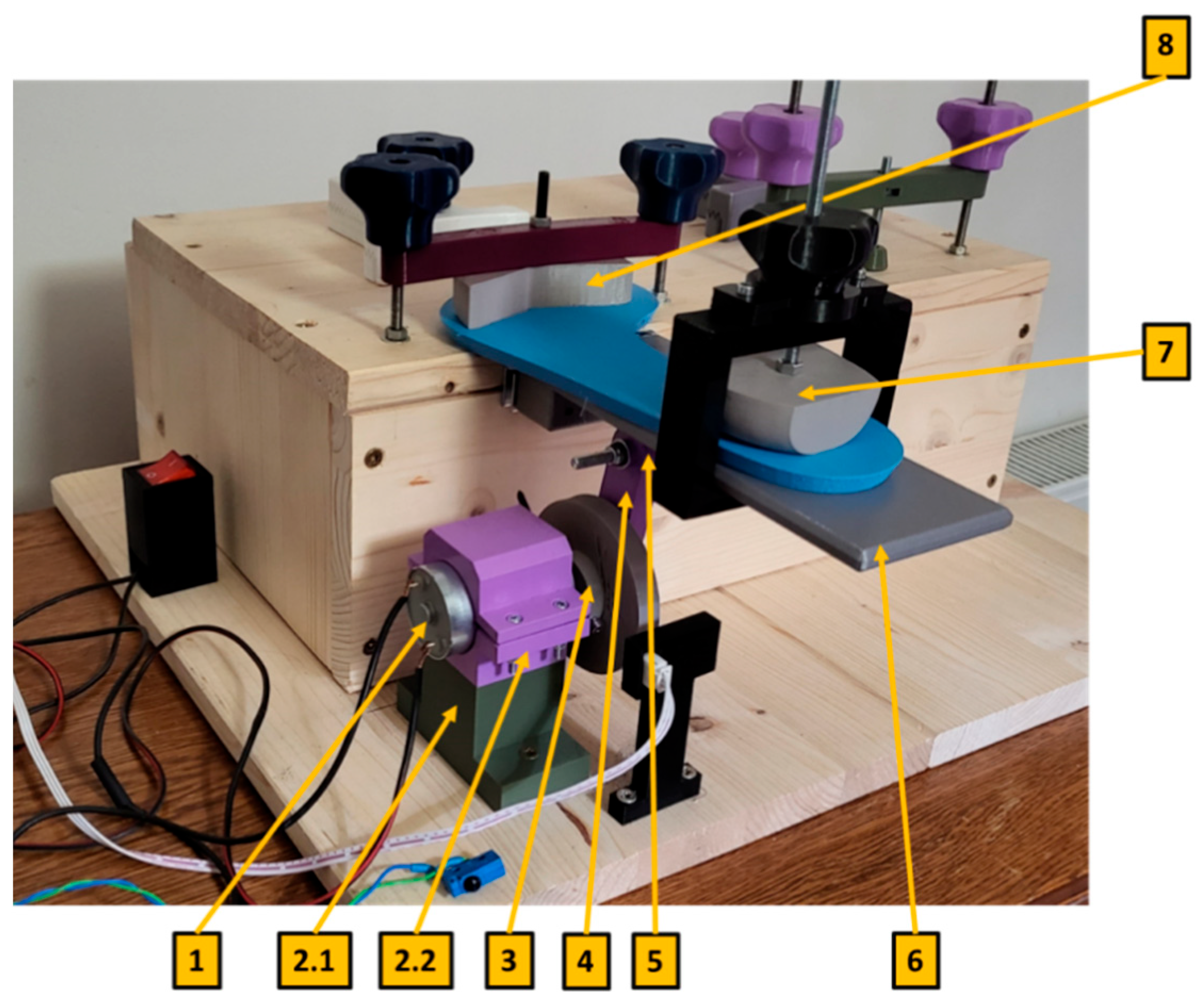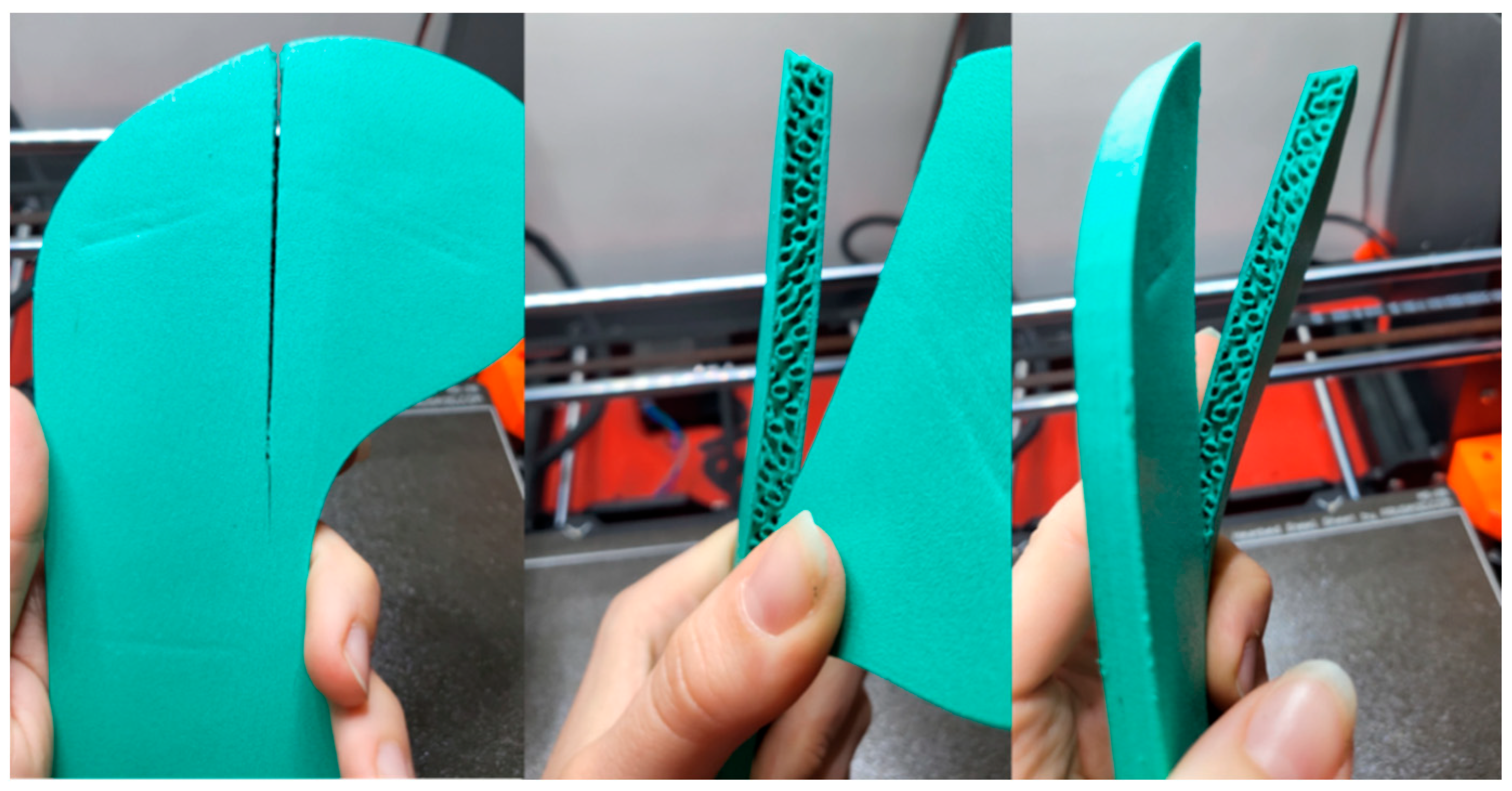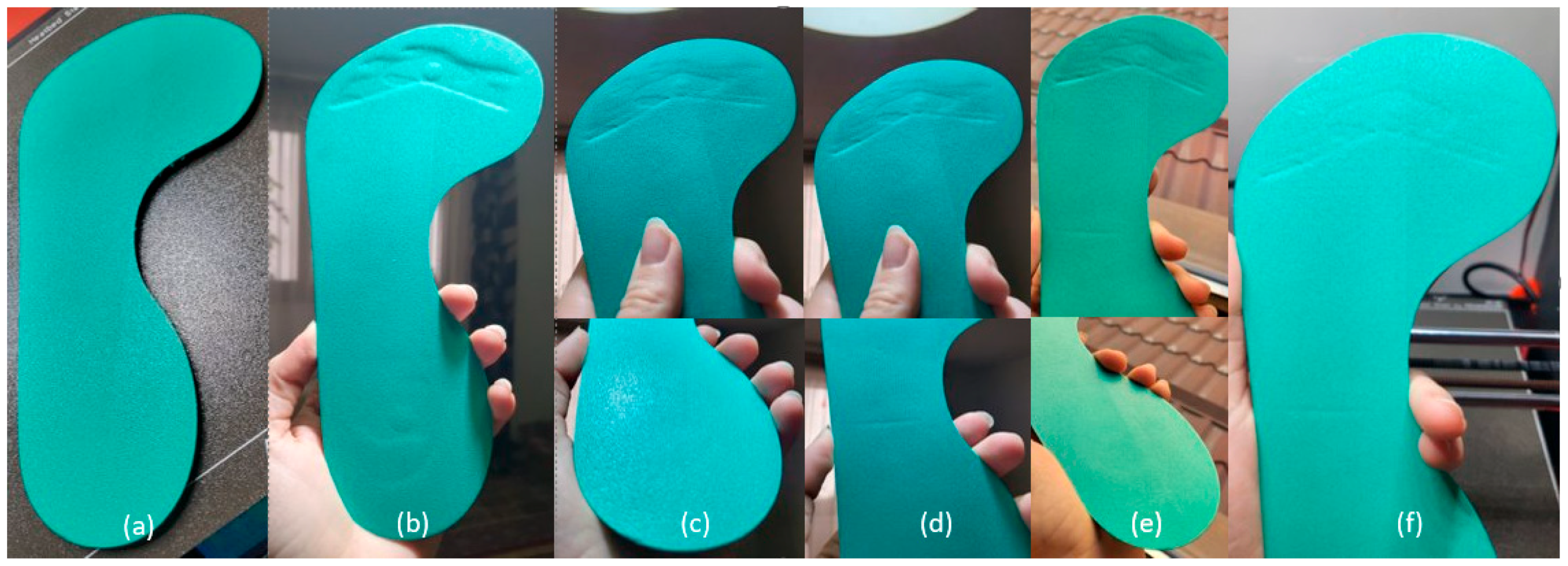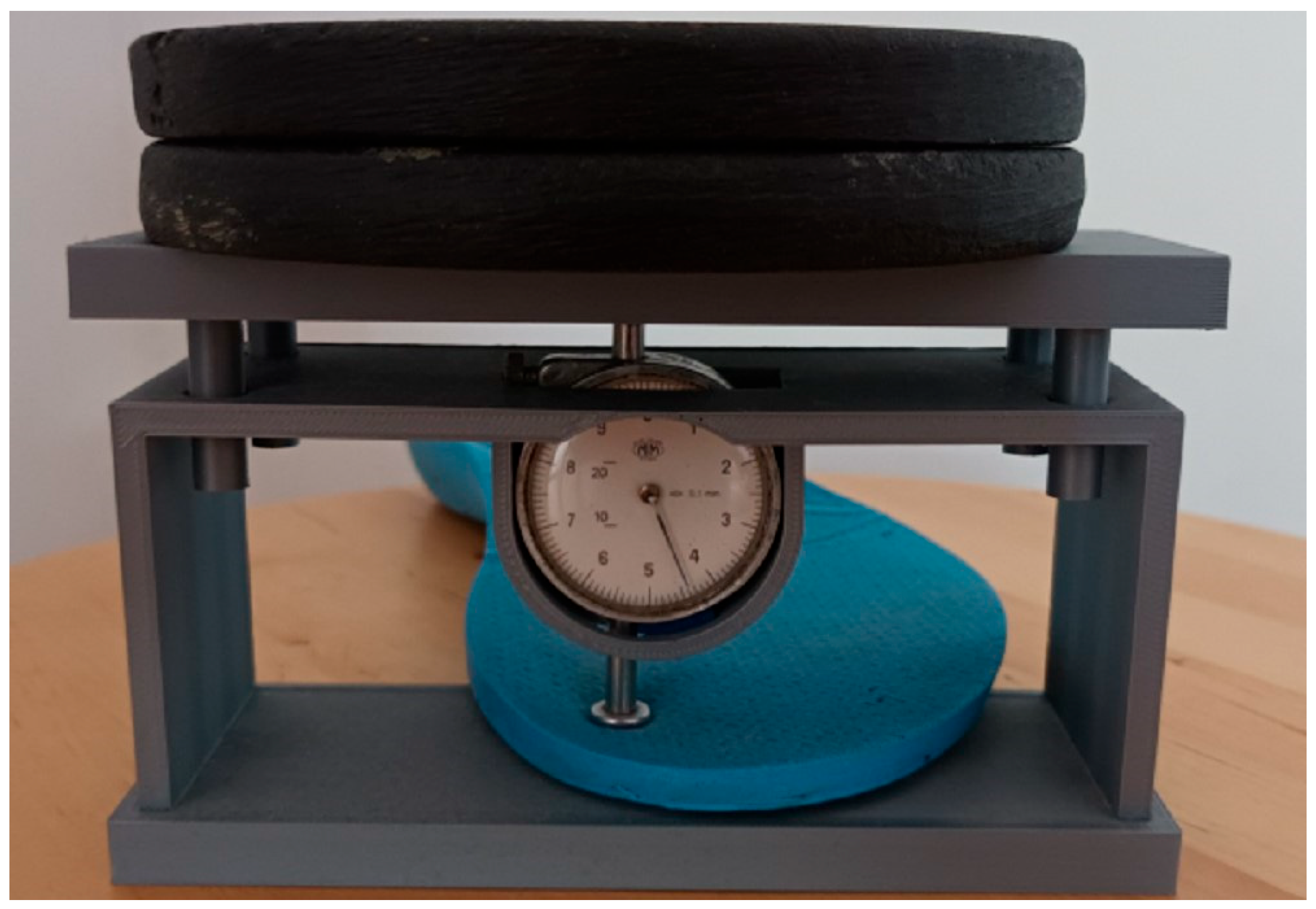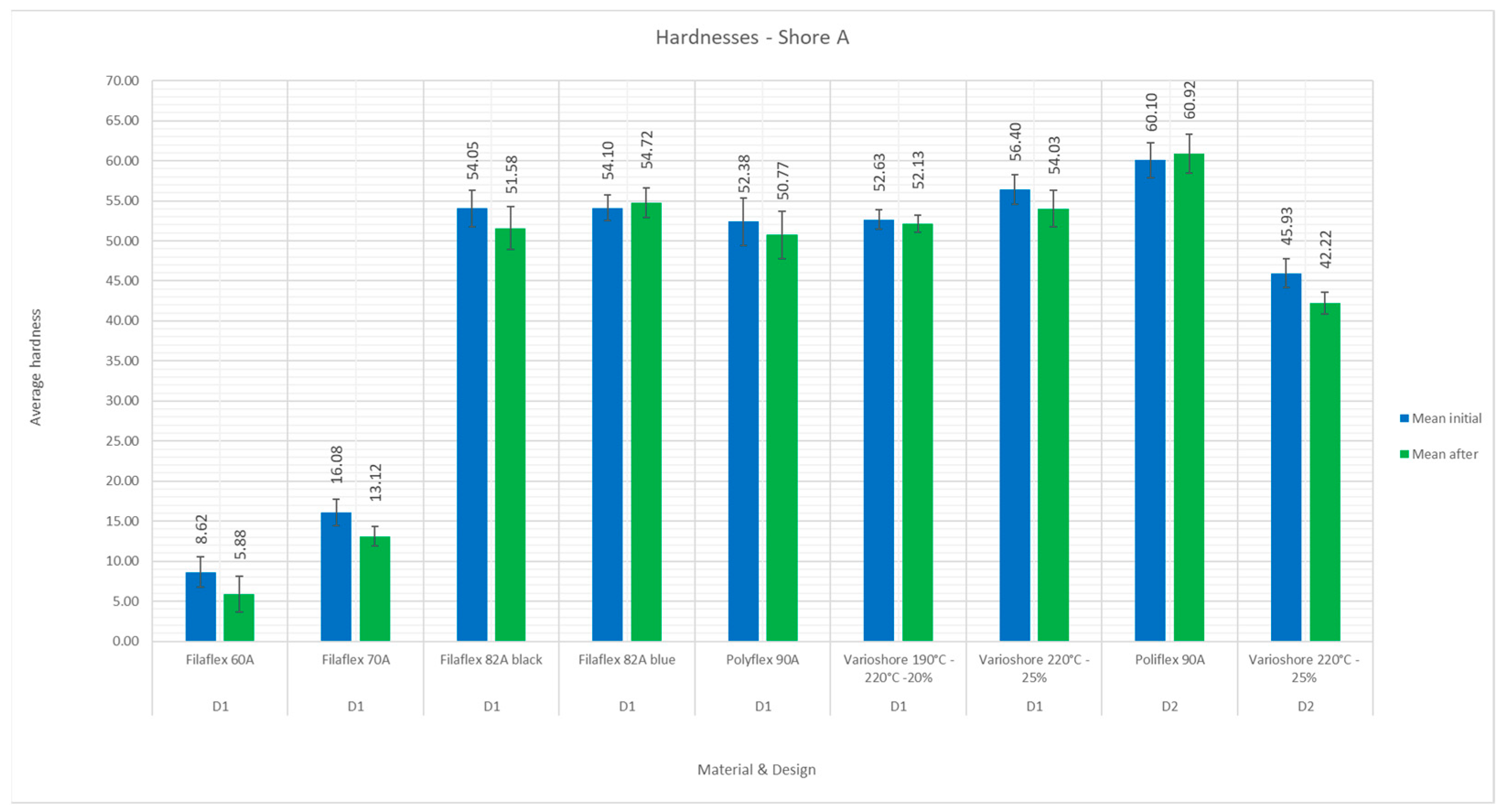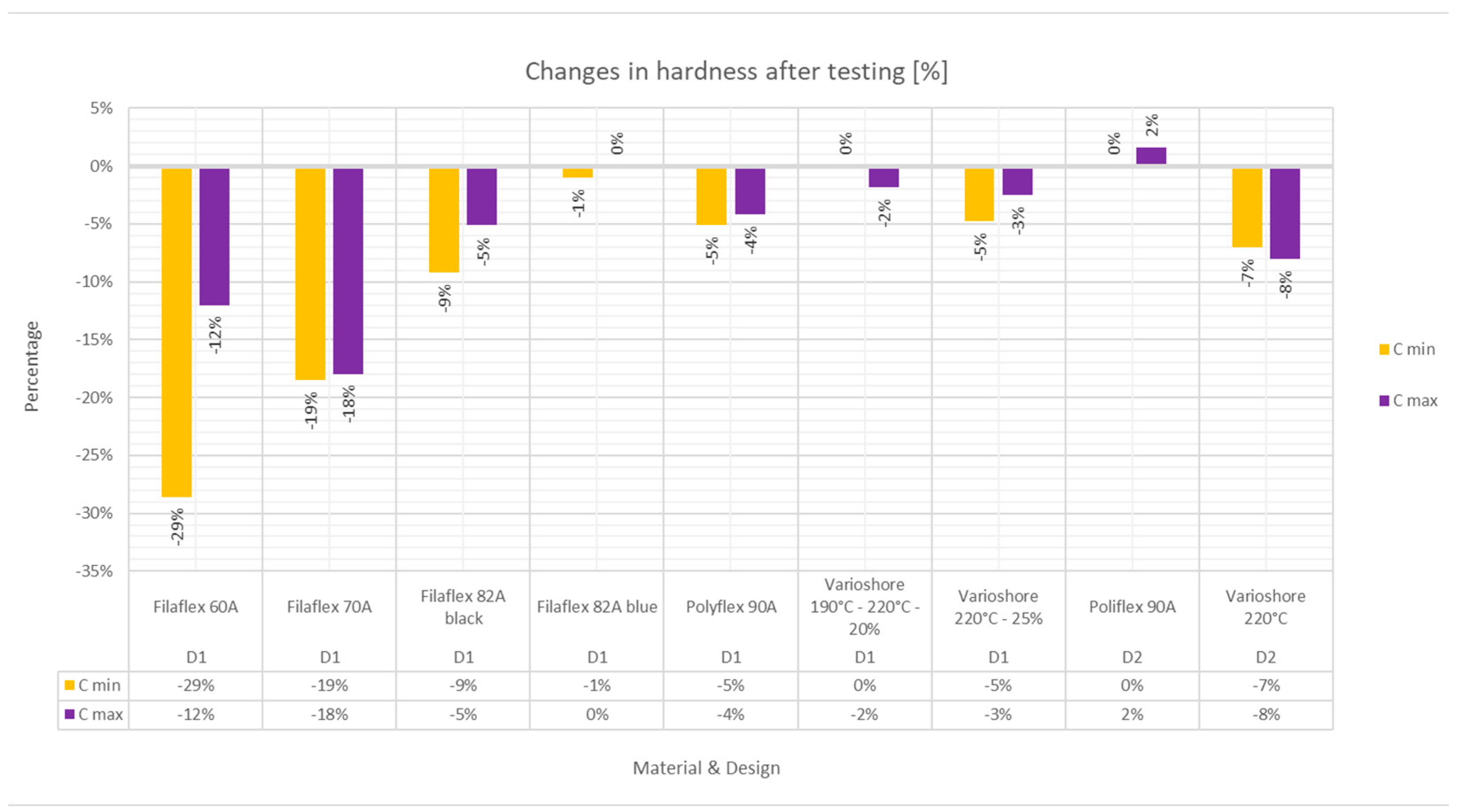1. Introduction
The last several years have shown an increasing interest in the applications and clinical assessments of Additive Manufacturing’s (AM) capability to produce user-customized orthotic products such as upper limb braces and casts [
1,
2], prostheses [
3], neck and back braces [
4,
5], and foot orthoses, colloquially known as insoles [
6,
7,
8]. All these medical devices are used to alleviate discomfort and pain, to support or improve the functions of limbs or other body parts, to prevent injuries, and to assist the healing process.
Various foot pathologies need insoles for improvement in daily living activities; pain and functional impairment during walking, flexible and rigid flat foot, cavus foot, diabetic foot, heel spur, and plantar fasciitis are among them. The main purpose of orthotic interventions is to address the too-rigid foot by using specific materials that enhance foot flexibility and shock absorption through custom biomechanical foot orthoses [
9]. There is room for improvement in insole fabrication in order to obtain a product that is comfortable for the patient, easy to be worn in all kinds of shoes, as well as durable. Only a comfortable, easy-to-wear, and durable insole will be helpful in achieving patients’ compliance with orthotic therapy. This is why customized insoles are expected to gradually replace conventional technologies, an evolution seen before in the orthosis field [
10]. In this sense, the main benefit offered by AM technology is the ability to adapt the design of these products to fit an individual’s specific body shape, size, and medical condition, in contrast to the prefabricated and off-the-shelf products [
11]. In the case of 3D-printed insoles, design customization refers not only to their shape and dimensions but also to the design of various stiffness zones that can accommodate various plantar pressures. This feature proves highly beneficial for individuals with conditions like diabetes [
7], where the nominal pressure and area of contact are changing continuously because of weak foot stability and progressive deterioration in midfoot joints and bones [
12]. The variable stiffness is commonly obtained by infill density and pattern settings [
13], but new filaments, such as varioShore TPU—thermoplastic polyurethane (Colorfabb, Bremweg, The Netherlands), also enable hardness variation through printing temperature settings [
14].
During use, the insoles typically undergo a series of movements that alternate with periods of rest, the cyclic flexion movements in the forefoot area representing the primary mechanical stress. Hence, the footwear testing related to fatigue resistance is focused on this zone by using dedicated equipment [
15,
16]. As far as the authors are aware, there have been no published investigations into the similar testing of 3D-printed insoles. Conducting initial tests on these medical devices will facilitate the examination of various 3D printing configurations with the goal of reducing failure rates during real-world usage and improving their reliability.
A limited number of studies are available in the scientific literature that offer data on the impact of various types of elastomers or 3D printing settings on the mechanical durability of insoles, whether through real-world usage or laboratory testing. The effect of the infill pattern on insoles’ hardness was investigated by Yarwindran et al. [
17], but tests were performed on specimens subjected to tensile and flexural loads, rather than cyclic flexion testing. Orsu et al. [
18] conducted a study on the compressive strength of PolyFlex TPU specimens, investigating four infill patterns and three infill densities to customize different areas of insoles based on experimental outcomes. Similarly, Ma et al. [
19] aimed to modify the infill gradient and contact stress through infill design in diabetic insoles to achieve the same goal.
All the aforementioned studies examined the short-term use and the peak plantar pressure reduction achieved by 3D-printed insoles. They did not evaluate their fatigue life, which is an essential factor to consider in real-world scenarios. To this end, the purpose of this research was to investigate by experimental means the fatigue behavior under the cyclic flexion of insoles made of various TPU materials with different shore A hardness levels, as there are no available literature data on this topic. The mechanical tests were performed on dedicated equipment developed with the purpose of simulating flexion cyclic stress in the metatarsophalangeal area. Additionally, relevant data concerning fatigue life were gathered by monitoring the daily use of two different foot orthoses for varying durations, measured in terms of the number of steps taken (200,000 and 1,400,000 steps, respectively).
The foot insoles, made of TPU Filaflex filaments (Recreus, Elda, Spain), PolyFlex (Polymaker, Changshu, China) with shore hardness values of 60A, 70A, 82A, and 90A, as well as varioShore TPU insoles, were also tested by a user to assess comfort during a fifteen-minute walk.
2. Materials and Methods
2.1. Insoles Design
This study employed two models of insoles (referred to as design 1 and design 2) 3D printed from TPU filaments with different shore A hardness values for assessing their flexural fatigue resistance and wear comfort. Both designs were customized to match the anatomical shape and dimensions of the foot of a healthy user, whose weight was 98 kg. Insoles design 1 (
Figure 1a) had a thickness of 7 mm and a flat top surface, while design 2 (
Figure 1b) had a thickness of 8 mm around the metatarsophalangeal area, as well as zones for accommodating the heel and for sustaining the arch of the foot. The foot orthoses designed according to the plantar shape of the foot (design 2) ensure a better redistribution of plantar pressure thanks to the increased contact area, while the flat orthoses (design 1) fit most easily inside footwear, serving as a standard element in many types of shoes. The area of focus in both orthoses, specifically the metatarsophalangeal joint area, is flat, enabling a more effective comparison between the two designs.
For design 1, the infill density was the same for all areas, 25%. For design 2, the heel area was 3D printed with 40% and 50% infill density, while the remaining sections of the insoles had infills of 20% and/or 24% on the left and right foot (
Figure 1b, up).
Filaflex 60A, Filaflex 70A, Filaflex 82A (blue and black), PolyFlex 90A, and varioShore were used for insoles design 1, and blue Filaflex 82A, PolyFlex 90A, and varioShore were used for insoles design 2.
2.2. 3D Printing the Insoles
The 3DP process parameters used for producing the Filaflex 60A, 70A, and 82A and PolyFlex 90A insoles are outlined in
Table 1, while
Table 2 presents the process parameters for the varioShore insoles. All the insoles were produced on an Original Prusa i3 MK3S+ 3D printer with a direct drive Revo extruder.
The varioShore filament is based on active foaming technology, allowing for the manipulation of hardness properties by adjusting process parameters (such as the printing temperature or printing speed) that impact the degree of expansion. For this study, two variants of varioShore insoles were obtained (
Figure 2a) by adjusting the printing temperature to 190 °C and 220 °C, corresponding to the less foamed and the highly foamed states, respectively. Thus, the one type was 3D printed entirely at 220 °C (insole denoted varioShore 1), while the second type had the bottom five layers printed at 190 °C and the remaining layers 3D printed at 220 °C (insole denoted varioShore 2). varioShore 1 and varioShore 2 had design 1, while varioShore 2 was a design 2 type.
Figure 2 displays the varioShore insoles, where a noticeable distinction in color can be observed (
Figure 2b), indicating the presence of two hardness levels in the material.
varioShore TPU is a relatively new 3D printing filament material that has not been extensively investigated. Consequently, several specific aspects related to the 3D printing of this material and obtaining insoles with different levels of hardness on the vertical direction by setting the printing temperature are presented further. A correlation between the flow rate and printing temperature should be established in the calibration phase to avoid printing failures. For instance, at 190 °C and 1.25 flow, extrusion problems occurred, as the material was too soft and heated fast within the extruder, while reducing the printing speed also caused filament deformation. Based on tests, a flow rate of 1.1 yielded satisfactory results, with the exception of challenges encountered when changing the angle from the side. The necessary changes were made by modifying the g-code of the insole directly from the slicer by introducing new lines of code.
Table 1 and
Table 2 summarize the manufacturing parameters for Filaflex and PolyFlex insoles and varioShore insoles, respectively.
2.3. Insoles Testing
The insoles were tested as follows:
Design 1:
Filaflex 60A—flexural fatigue on the testing device;
Filaflex 70A—flexural fatigue on the testing device;
Filaflex 82A (blue)—daily use followed by flexural fatigue on the testing device;
PolyFlex 90A—flexural fatigue on the testing device;
varioShore 1—flexural fatigue on the testing device;
varioShore 2—flexural fatigue on the testing device.
Design 2:
Filaflex 82A (black)—daily use;
PolyFlex 90A—flexural fatigue on the testing device;
varioShore—flexural fatigue on the testing device.
In all cases, the insoles underwent testing in sets of 7000 cycles, after which they were evaluated through a combination of visual observations and the distinctive sound produced by the damaged infill structure when pressed by finger or flexed by hand. This is how users are instructed by the podiatrist to identify internal damage in the insole without the need for destructive inspection, thus determining the optimal time for orthotic replacement. The testing procedure replicated the daily wear and tear experienced by insoles, where periods of flexion alternate with periods of rest. The flexural tests were stopped after 700,000 steps in the absence of any signs of damage to the insoles.
2.3.1. Apparatus for Testing the Flexural Fatigue of Insoles
The testing apparatus was designed to fulfill the following specifications:
To allow for repeated cycles of flexion movements along the natural flexing line corresponding to the metatarsophalangeal area;
To accommodate a large range of insole sizes, from those suitable for children to those for adult males;
To allow for applying a set pressure in the metatarsophalangeal area for simulating the pressure exerted by the mass of the human body to the insoles;
To be cost-efficient (wood, 3D-printed parts, standard mechanical components);
To include a counter for the flexion cycles;
To implement a control program with combined phases of walking and resting.
In the absence of other available specifications, the maximum flexion angle was determined according to the requirement specified in the ISO 17707:2005 standard for outsoles [
16]. As a result, the foot orthoses underwent repetitive lifting at a 45° angle relative to the horizontal plane.
The insoles were placed on the 70 mm × 185 mm support, their length being adjusted by setting the position of the clamp corresponding to the hindfoot area, the clamp for the forefoot having a fixed position. Pressure was exerted by the clamps mass and by tightening the screws on the forefoot and hindfoot zones. The pressure applied to the forefoot zone was set to 176 kPa, a value comparable to those reported in [
20] for a group of healthy subjects in the same forefoot area of interest.
Figure 3 presents the testing apparatus. Its 3D-printed components were manufactured from (PLA) the same Ender 3 Pro 3D printer with a Revo extruder (Shenzhen Creality 3D Technology Co., Ltd., Shenzhen, China), with a 100% infill density and 0.2 mm layer thickness.
A Pololu 19:1 geared DC motor (1) powered the testing apparatus and transferred the motion to a drive disc (3) positioned on its shaft. The motor was affixed to a support structure (2), made up of a stationary component (2.1) and a mobile component (2.2) consisting of two parts. It runs on 12 volts at a rotational speed of 470 rpm. The drive disc moves the connecting rod (4), which was responsible for converting rotational motion to translational motion. The connecting rod was attached to the orthosis surface via a joint (5), which enables the rotational motion to be transformed into translational motion for the flexural fatigue test. The insole was placed on a 3D-printed PLA support (6), and the hindfoot area (7) was adjusted by positioning the clamp while the forefoot clamp (8) remained stationary. The testing device’s control and command system consisted of a Creality V1.1.3 board, which offered an input and operational voltage range of 12 V/24 V, making it suitable for powering the apparatus motor and other components. It also featured a microcontroller enabling the user to program and control the device’s functionalities. Alongside the Creality V1.1.3 board, the control and command system included sensors, control buttons, and a power supply connected to the control board via appropriate cables.
2.3.2. Daily Use Testing
As mentioned, two of the foot orthoses (Filaflex 82 A black design 1 and Filaflex 82 A blue design 2) underwent testing during daily usage. The Filaflex 82A black insole was worn for approximately 200,000 steps and left to rest on a shelf for almost one year before being subjected to flexural fatigue tests using the dedicated equipment. Similarly, the design 2 insole from blue Filaflex 82A was worn for 1,423,452 steps over a span of 203 days, averaging around 7000 steps per day, which is a recommended daily value that minimizes various health risks [
21].
After 310,000 steps, blue Filaflex 82A design 2 insoles were evaluated using an in-shoe Pedar (Novel GmbH, Munchen, Germany) pressure measurement system, and the data were compared with the original insole of the shoes (
Figure 4).
2.4. Measurements of the Hardness of 3D-Printed Insoles
The hardness of the insoles was assessed with a type A durometer by measuring 30 points on the surface of the insoles (
Figure 5) and computing the average. A total of 30 measurements were conducted immediately following the printing of the insoles, and an additional 30 measurements were taken after subjecting the insoles to testing on the fatigue test stand or walking. The second hardness measurements were taken approximately 36–48 h after testing the insoles on the device.
The measured points on the initial foot orthoses were selected to cover their whole surface, while the measurements on the tested insoles were concentrated more on the zones of testing and contact with the clamps (forefoot and heel) (
Figure 6). After testing the insoles using one or both of the two types of tests used in this application (flexural fatigue on the testing device and/or real wear conditions followed by flexural fatigue on the testing device), the final measurements of hardness were performed. According to the standard ISO-7619-1-2004—Determination of indentation hardness [
22], the time to measure a point with the type A durometer is 3 s, because the hardness value drops significantly during the first few seconds.
The hardness measurements in 30 points were used to calculate the average hardness in the initial state of the insole (
mi) and after the tests (
ma) and the deviation from the mean, which allowed for evaluating the variance within the set of numbers in comparison to their mean:
where
Px,y = value of the measured point,
mx,y = mean,
x = values from 1 to 30, and
y = state (initial/after tests).
In the 30 points measured initially and after the tests, different minimum and maximum hardness values were found. To determine the percentage by which the hardness of the insoles changed after testing, the following expressions were used:
where
Cmin = the percentage by which the hardness of the insoles changed after testing for the minimum values,
Cmax = the percentage by which the hardness of the insoles changed after testing for the maximum values,
Pi,min = minimum value of the initially measured point,
Pa,min = the minimum value of the point measured after the test,
Pi,max = maximum value of the initially measured point, and
Pa,max = the maximum value of the point measured after the test.
3. Results and Discussions
Figure 7 and
Figure 8 present various images of the insoles after testing, with cuts made to highlight potential changes in the gyroid infill structure.
The exterior structure of all the insoles remained intact, both during real-life conditions testing and after testing them for flexural strength assessment on the apparatus. Except for the black Filaflex 82A design 1 insole tested under real-life conditions followed by cyclic flexion on the device, none of the insoles exhibited any damage to their internal structures during the flexural fatigue tests. The black Filaflex 82A insole interior structure failed after around 7000 cycles on the device; delamination between the infill layers occurred, as can be noticed in
Figure 7. It is presumed that the damage was a result of wear and tear under specific conditions (such as high temperatures and sweat during the summer) and aging, considering that the insole was subjected to testing a year after being stored in uncontrolled conditions on a shelf. Further investigation is required to validate this hypothesis.
Figure 8 presents the evolution of the exterior surface of the varioShore 1 design 1 insole after a specific number of cycles. One can observe the zones with compression marks corresponding to the positions of the two clamps in the forefoot and hindfoot, which compressed the material, leaving non-remanent deformations. In the heel area, the marks vanished quickly between the testing cycles, leaving only surface rubbing marks caused by the clamp area. In the forefoot area, the marks were deeper because the clamping pressure was twice as high as in the heel area, but over time, their intensity also diminished (
Figure 9f).
In contrast, the compression marks on the Filaflex and PolyFlex TPU insoles were less prominent. This observation was confirmed by the user who tested the insoles for comfort, noting that these deformations, which were perceived as a reduction in rigidity, occurred more rapidly in varioShore insoles compared to the others.
The same type of infill failure as for the black Filaflex 82A design 1 was also observed for the blue Filaflex 82A design 2 right foot insole after 1,423,452 steps. However, the left foot insole with a 24% infill density in the metatarsophalangeal zone did not fail.
In-shoe Pedar measurements (
Figure 10) have shown a decrease in the peak pressure when wearing the orthoses. The 3D-printed blue Filaflex 82A design 2 insole reduced the maximum pressures observed in the forefoot area compared to the original insole of the shoes, from 250 kPa to 207 kPa (17% reduction) for the left foot (with 24% infill) and from 305 kPa to 280 kPa (9% reduction) for the right foot (20% infill). These values are smaller than those provided by Birke et al. [
23] for flat PORON insoles. The pressure in the heel area was redistributed to different hardness zones in the 3D-printed orthosis compared to the central area in the initial shoe insole.
For the insoles tested in a real-life scenario, the residual deformation after 1,000,001 steps was around 55% (4.4 mm of 8 mm) for the greater infill and 31.2% (2.5 mm of 8 mm) (
Figure 11). The literature on the physical properties of materials used in insoles for diabetic patients is reporting a residual deformation between 10 and 42% after 80,000 testing cycles (this number of 80,000 testing cycles is required in the shoe sole flexing test standards, and it represents just 8% of the real walking test performed for our research) [
24].
Table 3 provides a summary of the most important findings from the tests, including the shore A hardness and comfort evaluations. In this study, the comfort could only be correlated with the mechanical aspect (cushioning), as the testing time was too short to evaluate aspects related to specific aspects such as moisture and heat transfer, which remain an open subject for future research.
The user feedback on the insoles’ comfort is synthetically presented below:
Filaflex 82A black and blue, design 1—the hardness of the insole was too high, making it difficult to bend it in the forefoot area of the shoe (black insole—the top surface of the insole was too rough and felt uncomfortable, blue insole—the top surface was smooth);
PolyFlex 90A, design 1 and 2—the hardness of the insole was too high; it was difficult to bend it in the shoe in the forefoot area (design 1—the top surface of the insole was smooth, design 2—felt uncomfortable because of the thickness for the forefoot area where the toes are constrained);
VarioShore 1, design 1—the top surface was smooth, and the hardness of the insole felt high, but it was less difficult to bend than the previous insoles;
Filaflex 60A, design 1—the hardness of the insole was too low; the infill structure of the insole could be unpleasantly felt by the user during walking;
Varioshore, design 2—the hardness of the insole was high but lower than that of previous insoles, and it was easier to bend in the shoe, but it had too many constraints for the foot because of the thickness for the forefoot area;
Filaflex 70A, design 1—the hardness of the insole was too low, but it felt better than the Filaflex 60A insole; the infill from inside the insole could be felt by the user, but it was more comfortable to wear than the Filaflex 60A, and the weight of the body seemed to be sustained;
VarioShore 2, design 1—the hardness of the insole seemed almost perfect, it was easy to bend in the shoe, the top surface was smooth, and the weight of the body felt well sustained.
Figure 12 and
Figure 13 graphically represent the shore A hardness values for each tested insole, respectively; the deformation was determined by the pressure applied in the forefoot and heel foot areas.
Table 4 presents the results of the hardness measurements immediately after 3D printing and after the tests. The PolyFlex 90A design 1 insole exhibited the fewest deviations (0.03) between the two measurements, as seen in the graph in
Figure 12 and in
Table 4. The largest variations were observed in Filaflex 70A, with a difference of 0.45 from the initial measurement, followed by Varioshore 220 °C-25% (design 1 and 2), with −0.44 and 0.44.
When it comes to changes in insole hardness (both minimum and maximum values), it could be observed that the insoles least impacted by testing were Filaflex 82A blue, PolyFlex 90A, and varioShore 190 °C–220 °C-20%, while the most affected ones were Filaflex 60A and Filaflex 70A. In terms of comfort, varioShore 190 °C–220 °C-20% stands out due to its elasticity and foam-like structure, providing a supportive and cushioned feeling under weight. It exhibited minimal deviation from the initial measurements, with a value of −0.15, and maintained a hardness of approximately 52A.
4. Conclusions and Further Work
This research proposed several novelties, with the most notable being the evaluation of the flexural fatigue resistance of 3D-printed insoles manufactured through an additive manufacturing-based material extrusion process using various thermoplastic polyurethane filaments. The focus was the metatarsophalangeal area, being the most mechanically stressed one in cyclic flexion during walking or running. Another novel aspect was the testing of varioShore filament material, based on foaming technology, for the first time in this type of application.
Two different designs were examined, while two of the 3D-printed orthoses also underwent real-life wear scenarios. The results demonstrated that each orthosis, regardless of its design and the material used, withstood a minimum of 700,000 cycles in the testing conditions of a dedicated apparatus. Daily use was simulated by testing the insoles for 7000 cycles followed by a rest period, then another 7000 cycles, and so on. No surface damage was observed on the insoles, except for non-permanent deformations, which were more prominent in the varioShore samples.
The in-shoe Pedar measurements on insoles with a variable infill density demonstrated a reduction in plantar pressure, highlighting their effectiveness. These same insoles withstood over 1,400,000 steps during daily walking.
The primary conclusion drawn from this study was that the available TPU filaments are suitable for insole manufacturing when tested for flexural fatigue resistance. Variations in the materials’ shore A hardness resulted in different insole stiffnesses, which affects the plantar pressure and comfort. In this research, the most comfortable among the tested insoles was the varioShore model, which had a 20% infill density and was 3D-printed at a temperature of 220 °C. Thus, depending on the intended application (e.g., diabetic foot insoles, insoles for plantar fasciitis, insoles for prolonged standing, insoles for comfort, running, or other sports, etc., meaning different variations between the cushion and support), a filament can be chosen with the assurance that the insoles will endure at least two months of daily use.
Based on the experience of one insole which was worn during summer and then kept on a shelf for around one year and tested for flexural fatigue, which determined an internal damage of the infill structure, further research will assess the influence of different wear factors, as well as aging, on the flexural fatigue resistance of the 3D-printed TPU insoles.
Author Contributions
Conceptualization, D.P. (Diana Popescu); Data curation, M.C.I. and D.P. (Daniel Petcu); Formal analysis, M.C.I. and R.M.; Investigation, M.C.I., D.P. (Diana Popescu) and D.P. (Daniel Petcu); Methodology, M.C.I., D.P. (Diana Popescu) and D.P. (Daniel Petcu); Validation, D.P. (Diana Popescu) and R.M.; Writing—original draft, M.C.I. and D.P. (Diana Popescu); Writing—review and editing, M.C.I., D.P. (Diana Popescu), D.P. (Daniel Petcu) and R.M. All authors have read and agreed to the published version of the manuscript.
Funding
This research received no external funding.
Institutional Review Board Statement
Not applicable.
Informed Consent Statement
Informed consent was obtained from all subjects involved in the study. Written informed consent has been obtained from the patients to publish this paper.
Data Availability Statement
Available upon request.
Acknowledgments
We thank Doina Bucurat the Faculty of Mechanical Engineering and Mechatronics, National University of Science and Technology Politehnica Bucharest, Romania, for her support in conducting the in-shoe pressure measurements.
Conflicts of Interest
The authors declare no conflict of interest. Author Daniel Petcu is employed by the company Pedorthic Art S.R.L. The remaining authors declare that the research was conducted in the absence of any commercial or financial relationships that could be construed as a potential conflict of interest.
References
- Oud, T.; Tuijtelaars, J.; Bogaards, H.; Nollet, F.; Brehm, M.A. Preliminary effectiveness of 3D-printed orthoses in chronic hand conditions: Study protocol for a non-randomised interventional feasibility study. BMJ Open 2023, 13, e069424. [Google Scholar] [CrossRef] [PubMed]
- Waldburger, L.; Schaller, R.; Furthmüller, C.; Schrepfer, L.; Schaefer, D.J.; Kaempfen, A. 3D-Printed Hand Splints versus Thermoplastic Splints: A Randomized Controlled Pilot Feasibility Trial. Int. J. Bioprint. 2021, 8, 474. [Google Scholar] [CrossRef] [PubMed]
- Copeland, C.; Reyes, C.C.; Peck, J.L.; Srivastava, R.; Zuniga, J.M. Functional Performance and Patient Satisfaction Comparison between a 3D Printed and a Standard Transradial Prosthesis: A Case Report. BioMed. Eng. OnLine 2022, 21, 7. [Google Scholar] [CrossRef] [PubMed]
- Hale, L.; Linley, E.; Kalaskar, D.M. A Digital Workflow for Design and Fabrication of Bespoke Orthoses Using 3D Scanning and 3D Printing, a Patient-Based Case Study. Sci. Rep. 2020, 10, 7028. [Google Scholar] [CrossRef] [PubMed]
- Lu, D.; Li, W.; Wang, X.; Yan, S.; Zhang, P.; Feng, H.; Wu, Y.; Xu, Y.; Li, T.; Ma, Z.; et al. Case Study of a Personalized Scoliosis Brace Based on 3D Printing. J. Shanghai Jiaotong Univ. (Sci.) 2022, 27, 528–534. [Google Scholar] [CrossRef]
- Ahmed, S.; Barwick, A.; Butterworth, P.; Nancarrow, S. Footwear and Insole Design Features That Reduce Neuropathic Plantar Forefoot Ulcer Risk in People with Diabetes: A Systematic Literature Review. J. Foot Ankle Res. 2020, 13, 30. [Google Scholar] [CrossRef]
- Chatzistergos, P.E.; Gatt, A.; Formosa, C.; Farrugia, K.; Chockalingam, N. Optimised Cushioning in Diabetic Footwear Can Significantly Enhance Their Capacity to Reduce Plantar Pressure. Gait Posture 2020, 79, 244–250. [Google Scholar] [CrossRef]
- Zuñiga, J.; Moscoso, M.; Padilla-Huamantinco, P.G.; Lazo-Porras, M.; Tenorio-Mucha, J.; Padilla-Huamantinco, W.; Tincopa, J.P. Development of 3D-Printed Orthopedic Insoles for Patients with Diabetes and Evaluation with Electronic Pressure Sensors. Designs 2022, 6, 95. [Google Scholar] [CrossRef]
- Meier, R.; Cornell, K. Orthotic Management of the Cavovarus Foot. Clinical Innovations in Biomechanics. Available online: https://podiatrym.com/pdf/2022/12/MeierCornell123web.pdf (accessed on 21 September 2023).
- Choo, Y.J.; Boudier-Revéret, M.; Chang, M.C. 3D Printing Technology Applied to Orthosis Manufacturing: Narrative Review. Ann. Palliat. Med. 2020, 9, 4262–4270. [Google Scholar] [CrossRef] [PubMed]
- Jandova, S.; Mendricky, R. Benefits of 3D Printed and Customized Anatomical Footwear Insoles for Plantar Pressure Distribution. 3D Print. Addit. Manuf. 2022, 9, 547–556. [Google Scholar] [CrossRef]
- Hastings, M.K.; Mueller, M.J.; Woodburn, J.; Strube, M.J.; Commean, P.; Johnson, J.E.; Cheuy, V.; Sinacore, D.R. Acquired Midfoot Deformity and Function in Individuals with Diabetes and Peripheral Neuropathy. Clin. Biomech. 2016, 32, 261–267. [Google Scholar] [CrossRef]
- Teixeira, R.; Coelho, C.; Oliveira, J.; Gomes, J.; Pinto, V.V.; Ferreira, M.J.; Nóbrega, J.M.; Silva, A.F.d.; Carneiro, O.S. Towards Customized Footwear with Improved Comfort. Materials 2021, 14, 1738. [Google Scholar] [CrossRef]
- Güray Kalaycioğlu, Ş. Mechanical Behaviour of Polymeric Lattice Structures Produced by Additive Manufacturing. Master′s Thesis, School of Natural and Applied Sciences of Middle East Technical University, Ankara, Turkey, 2022. Available online: https://open.metu.edu.tr/handle/11511/101241 (accessed on 5 March 2023).
- ISO 24266; Footwear—Test Methods for Whole Shoe—Flexing Durability Chaussures—Méthodes d’Essai Pour Toute La Chaussure—Durabilité vis-à-vis de La Flexion. ISO: Geneva, Switzerland, 2020. Available online: https://cdn.standards.iteh.ai/samples/78251/df3f606ca3d140768d22f60888f4f020/ISO-24266-2020.pdf (accessed on 21 September 2023).
- ISO 17707:2005; Footwear—Test Methods for Outsoles—Flex Resistance. ISO: Geneva, Switzerland, 2005. Available online: https://www.iso.org/standard/31478.html (accessed on 21 September 2023).
- Yarwindran, M.; Sa’aban, N.A.; Ibrahim, M.; Periyasamy, R. Thermoplastic elastomer infill pattern impact on mechanical properties 3D printed customized orthotic insole. ARPN J. Eng. Appl. Sci. 2016, 11, 6519–6524. [Google Scholar]
- Orsu, B.; Shaik, Y.P. Compression Strength Analysis of Customized Shoe Insole with Different Infill Patterns Using 3D Printing. OALib 2022, 9, e8712. [Google Scholar] [CrossRef]
- Ma, Z.; Lin, J.; Xu, X.; Ma, Z.; Tang, L.; Sun, C.; Li, D.; Liu, C.; Zhong, Y.; Wang, L. Design and 3D Printing of Adjustable Modulus Porous Structures for Customized Diabetic Foot Insoles. Int. J. Lightweight Mater. Manuf. 2019, 2, 57–63. [Google Scholar] [CrossRef]
- Perttunen, J. Foot Loading in Normal and Pathological Walking. Academic Dissertation, University of Jyväskylä, Jyväskylä, Finland, 2002. Available online: https://jyx.jyu.fi/bitstream/handle/123456789/13508/9513912221.pdf (accessed on 10 February 2023).
- Tudor-Locke, C.; Craig, C.L.; Brown, W.J.; Clemes, S.A.; De Cocker, K.; Giles-Corti, B.; Hatano, Y.; Inoue, S.; Matsudo, S.M.; Mutrie, N.; et al. How Many Steps/Day Are Enough? For Adults. Int. J. Behav. Nutr. Phys. Act. 2011, 8, 79. [Google Scholar] [CrossRef] [PubMed]
- ISO 7619-1:2004; Rubber, Vulcanized or Thermoplastic—Determination of Indentation Hardness—Part 1: Durometer Method (Shore Hardness). ISO: Geneva, Switzerland, 2004. Available online: https://www.iso.org/standard/31078.html (accessed on 21 September 2023).
- Birke, J.A.; Foto, J.G.; Pfiefer, L.A. Effect of Orthosis Material Hardness on Walking Pressure in High-Risk Diabetes Patients. J. Prosthet. Orthot. 1999, 11, 43–46. [Google Scholar] [CrossRef][Green Version]
- Brodsky, J.W.; Pollo, F.E.; Cheleuitte, D.; Baum, B.S. Physical Properties, Durability, and Energy-Dissipation Function of Dual-Density Orthotic Materials Used in Insoles for Diabetic Patients. Foot Ankle Int. 2007, 28, 880–889. [Google Scholar] [CrossRef] [PubMed]
Figure 1.
Types of tested insoles: (a) uniform infill density and flat top surface (design 1); (b) variable infill density and supports for the heel and foot’s arch (design 2).
Figure 1.
Types of tested insoles: (a) uniform infill density and flat top surface (design 1); (b) variable infill density and supports for the heel and foot’s arch (design 2).
Figure 2.
varioShore insoles: (a) 220 °C printing temperature; (b) 190 °C and 220 °C printing temperatures.
Figure 2.
varioShore insoles: (a) 220 °C printing temperature; (b) 190 °C and 220 °C printing temperatures.
Figure 3.
Apparatus for insoles flexural fatigue testing.
Figure 3.
Apparatus for insoles flexural fatigue testing.
Figure 4.
In-shoe Pedar pressure measurement: (a) 3D-printed blue Filaflex 82A insoles (left); (b) original shoe insoles (right).
Figure 4.
In-shoe Pedar pressure measurement: (a) 3D-printed blue Filaflex 82A insoles (left); (b) original shoe insoles (right).
Figure 5.
Hardness measurements on varioShore insoles: (a) design 1; (b) design 2; (c) other insoles.
Figure 5.
Hardness measurements on varioShore insoles: (a) design 1; (b) design 2; (c) other insoles.
Figure 6.
Zones of the hardness measurements: (a) design 1; (b) design 2.
Figure 6.
Zones of the hardness measurements: (a) design 1; (b) design 2.
Figure 7.
Damaged interior structure of black Filaflex 82A TPU (real conditions testing followed by cyclic flexion on the testing apparatus). (a) Forefoot area; (b) Heel area.
Figure 7.
Damaged interior structure of black Filaflex 82A TPU (real conditions testing followed by cyclic flexion on the testing apparatus). (a) Forefoot area; (b) Heel area.
Figure 8.
varioShore 1 insole showing no damage of the gyroid infill.
Figure 8.
varioShore 1 insole showing no damage of the gyroid infill.
Figure 9.
varioShore 1 insole top surface evolution: (a) immediately after 3D printing; (b) after 7000 cycles; (c) after 42,000 cycles; (d) after 63,000 cycles; (e) after 98,000 cycles; (f) after 48 h.
Figure 9.
varioShore 1 insole top surface evolution: (a) immediately after 3D printing; (b) after 7000 cycles; (c) after 42,000 cycles; (d) after 63,000 cycles; (e) after 98,000 cycles; (f) after 48 h.
Figure 10.
In-shoe Pedar results for blue Filaflex 8A insoles design 2 (black—15 kPa, dark blue—40 kPa, light blue—60 kPa, green—100 kPa, red—200 kPa, magenta—300 kPa).
Figure 10.
In-shoe Pedar results for blue Filaflex 8A insoles design 2 (black—15 kPa, dark blue—40 kPa, light blue—60 kPa, green—100 kPa, red—200 kPa, magenta—300 kPa).
Figure 11.
Measuring the residual deformation of a worn insole.
Figure 11.
Measuring the residual deformation of a worn insole.
Figure 12.
Shore A hardness results: initial—immediately after 3D printing (blue); after—post-testing (green).
Figure 12.
Shore A hardness results: initial—immediately after 3D printing (blue); after—post-testing (green).
Figure 13.
Hardness changes of the insoles after testing.
Figure 13.
Hardness changes of the insoles after testing.
Table 1.
3D printing process parameters for the Filaflex and PolyFlex insoles.
Table 1.
3D printing process parameters for the Filaflex and PolyFlex insoles.
| Material | Printer Settings | Parameter Settings |
|---|
| Filaflex 60A | Bed temperature:
- First layer: 30 °C
- Other layers: 0 °C/bed Heating turned off
Nozzle temperature: 215 °C
Flow rates: 100% | Layer thickness: 0.3 mm
Top/bottom layers: 1
Minimum shell thickness top/bottom: 0.7 mm/0.5 mm
Perimeters: 1
Infill densities: 25%
Infill pattern: Gyroid
Printing speed: 15 mm/s
Fan speed: 30%
Disabled for the first 4 layers, full at layer 6 |
| Filaflex 70A | Bed temperature:
- First layer: 40 °C
- Other layers: 0 °C/bed Heating turned off
Nozzle temperature: 228 °C
Flow rates: 78% | Layer thickness: 0.3 mm
Top/bottom layers: 1
Minimum shell thickness top/bottom: 0.7 mm/0.5 mm
Perimeters: 1
Infill densities: 25%
Infill pattern: Gyroid
Printing speed: 15 mm/s
Fan speed: 30%
Disabled for the first 4 layers, full at layer 6 |
| Filaflex 82A | Bed temperature: 40 °C
Nozzle temperature: 240 °C
Flow rates: 115% | Layer thickness: 0.3 mm
Top/bottom layers: 1
Minimum shell thickness top/bottom: 0.7 mm/0.5 mm
Perimeters: 1
Infill densities: 20%, 25%, 40% in different zones of the insoles
Infill pattern: Gyroid
Printing speed: 20 mm/s
Fan speed: 50%
Disabled for the first 4 layers, full at layer 6 |
| PolyFlex 90A | Bed temperature: 215 °C
Nozzle temperature: 40 °C
Flow rates: 98% | Layer thickness: 0.3 mm
Top/bottom layers: 1
Minimum shell thickness top/bottom: 0.7 mm/0.5 mm
Perimeters: 1
Infill densities: 20%, 50% in different zones of the insoles
Infill pattern: Gyroid
Printing speed: mm/s
Fan speed: min. 30%–max. 50%
Disabled for the first 4 layers, full at layer 6 |
Table 2.
3D printing process parameters for the varioShore insoles.
Table 2.
3D printing process parameters for the varioShore insoles.
| Material | Fixed Parameters | Variable Parameters |
|---|
| varioShore 1 | Bed temperature: 50 °C
Layer thickness: 0.3 mm
Top/bottom layers: 1
Minimum shell thickness top/bottom: 0.7 mm/0.5 mm
Perimeters: 1
Infill pattern: Gyroid
Printing speed: 35 mm/s
First layer printing speed: 10 mm/s
Fan speed: 60%
Disabled for the first 4 layers, full at layer 6 | Nozzle temperature: 220 °C
Flow rates: 60%
Infill density: 25% |
| varioShore 2 | Nozzle temperature: 190 °C (the first 1.4 mm) and 220 °C
Flow rates: 110% and 60%
Infill density: 20% |
Table 3.
Hardness and comfort test results.
Table 3.
Hardness and comfort test results.
| Specimen | Hardness before Testing (HA) | Hardness after Testing (HA) | Type of Damage | Number of Cycles until Damage | Total Number of Cycles | Comfort User’s Evaluation |
|---|
| Filaflex 60A design 1 | 3.5–12.5 | 2.5–11 | Compression and
rubbing marks | No damage to the infill structure | 700,000 | 2 |
| Filaflex 70A design 1 | 13.5–19.5 | 11–16 | Compression and
rubbing marks | No damage to the infill structure | 700,000 | 4 |
| Filaflex 82A black design | 49–58.5 | 44–55.5 (damaged area) | Internal structure | Around 7000 cycles until cracks were heard (interior structure failure) | 500,000
following 200,000 steps in daily use | 1 |
| Filaflex 82A blue design 1 | 51.5–58 | 51–58 | Slight compression marks | No damage to the infill structure | 700,000 | 1 |
| PolyFlex 90A design 1 | 49–59.5 | 46.5–57 | No damage | No damage to the infill structure | 700,000 | 2 |
| varioShore 1 design 1 | 53–60 | 50.5–58.5 | Compression and
rubbing marks | No damage to the infill structure | 700,000 | 2 |
| varioShore 2 design 1 | 50–55 | 50–54 | Compression and
rubbing marks | No damage to the infill structure | 700,000 | 5 |
| PolyFlex 90A design 2 | 56.5–63.5 | 56.5–64.5 | Compression and
rubbing marks | No damage to the infill structure | 700,000 | 2 |
| Varioshore design 2 | 43–50 | 46–46 | Compression marks | No damage to the infill structure | 700,000 | 3 |
Table 4.
Standard deviation: initial (SDi) and after tests (SDa).
Table 4.
Standard deviation: initial (SDi) and after tests (SDa).
| Material | Design | SDi | SDa | SDa − SDi |
|---|
| Filaflex 60A | D1 | 1.89 | 2.21 | 0.32 |
| Filaflex 70A | D1 | 1.68 | 1.23 | −0.45 |
| Filaflex 82A black | D1 | 2.30 | 2.65 | 0.35 |
| Filaflex 82A blue | D1 | 1.61 | 1.85 | 0.24 |
| PolyFlex 90A | D1 | 2.93 | 2.96 | 0.03 |
| Varioshore 190 °C–220 °C-20% | D1 | 1.22 | 1.07 | −0.15 |
| Varioshore 220 °C-25% | D1 | 1.83 | 2.27 | 0.44 |
| PolyFlex 90A | D2 | 2.18 | 2.44 | 0.25 |
| Varioshore 220 °C-25% | D2 | 1.80 | 1.36 | −0.44 |
| Disclaimer/Publisher’s Note: The statements, opinions and data contained in all publications are solely those of the individual author(s) and contributor(s) and not of MDPI and/or the editor(s). MDPI and/or the editor(s) disclaim responsibility for any injury to people or property resulting from any ideas, methods, instructions or products referred to in the content. |
© 2023 by the authors. Licensee MDPI, Basel, Switzerland. This article is an open access article distributed under the terms and conditions of the Creative Commons Attribution (CC BY) license (https://creativecommons.org/licenses/by/4.0/).
